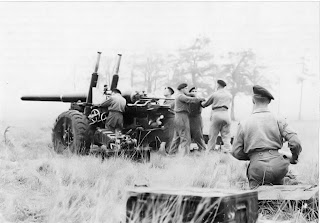The Royal Artillery in WW2
From a thread on the BBC WW2 People's War Message Board it would appear that there is some confusion as to what guns were used and which formations used them. I shall exclude anti-aircraft artillery (the HAA in fact had lighter guns than Medium Regiments) and the self-propelled guns of the Royal Horse Artillery.
The main artillery support at divisional level was the field regiment mostly equipped with 25 pdr guns towed by 4×4 'Quad' motorised tractors with separate ammunition limbers. Field regiments were organised into three eight-gun batteries, each of two four-gun troops.
Next up were the Mediums. All Medium Regiments and Medium Batteries were Corps artillery. Initially the gun was the 6 inch howitzer, replaced in 1942 by the 5.5 inch howitzer. Their firepower could be superimposed on any divisional field fireplan.
I have not been able to locate a photo of the 5.5 inch on the Internet, so I have scanned a couple I have.

This is a BL 5.5 inch Mk 3 gun being loaded. The shell is being rammed in. Rammers always face away from the breech and are guided by the NCO in front. To the right, behind the rammers, the breech operator is re-loading the firing lock and to the left the gun layer is lining up the gun sights. The sergeant in the foreground is dashing forward with the cartridge which will be fitted to the shell, having ensured that the correct amount of propellant is in the cartridge. Given the calm demeanour this is possibly a training session.

This dramatic shot shows a gun-crew in action in battle. Note the tenseness of these young gunners and the concentration on the breech operator's face. Once the gun starts firing its position is revealed and the gun cannot be moved, come what may, and it will, they have to keep on firing.
Next up were the heavies (Hy) and superheavy (Superhy) formations. These were either Corps or Army artillery. The Heavy Regiments RA were equipped with the 7.2 inch howitzer, the 9.2 inch howitzer, and the 9.2 inch gun. By 1944 half of the heavy batteries in 21st Army Group were equipped with American 155mm guns, a truly mighty weapon.
A Canadian website here explains this more fully. The organization of British artillery was exactly the same, including Mike, Uncle, and Victor target procedures.
The main artillery support at divisional level was the field regiment mostly equipped with 25 pdr guns towed by 4×4 'Quad' motorised tractors with separate ammunition limbers. Field regiments were organised into three eight-gun batteries, each of two four-gun troops.
Next up were the Mediums. All Medium Regiments and Medium Batteries were Corps artillery. Initially the gun was the 6 inch howitzer, replaced in 1942 by the 5.5 inch howitzer. Their firepower could be superimposed on any divisional field fireplan.
I have not been able to locate a photo of the 5.5 inch on the Internet, so I have scanned a couple I have.

This is a BL 5.5 inch Mk 3 gun being loaded. The shell is being rammed in. Rammers always face away from the breech and are guided by the NCO in front. To the right, behind the rammers, the breech operator is re-loading the firing lock and to the left the gun layer is lining up the gun sights. The sergeant in the foreground is dashing forward with the cartridge which will be fitted to the shell, having ensured that the correct amount of propellant is in the cartridge. Given the calm demeanour this is possibly a training session.

This dramatic shot shows a gun-crew in action in battle. Note the tenseness of these young gunners and the concentration on the breech operator's face. Once the gun starts firing its position is revealed and the gun cannot be moved, come what may, and it will, they have to keep on firing.
Next up were the heavies (Hy) and superheavy (Superhy) formations. These were either Corps or Army artillery. The Heavy Regiments RA were equipped with the 7.2 inch howitzer, the 9.2 inch howitzer, and the 9.2 inch gun. By 1944 half of the heavy batteries in 21st Army Group were equipped with American 155mm guns, a truly mighty weapon.
A Canadian website here explains this more fully. The organization of British artillery was exactly the same, including Mike, Uncle, and Victor target procedures.

2 Comments:
Thank you Peter for clearing that up - I never knew that - once when we lost a tank we had to sit there all night waiting for a new one to appear - we were then surrounded by a four gun battery of what to me looked like 4.5's who set up a running barrage most of the night - it was not peaceful - in the a.m. we than had to walk back to the FDS - had a sumptious meal - with peaches and cream for after - had shower and change of clothes - picked up another tank and went on our way....
In WW1 the artillery is sometimes listed as R.F.A (Royal Field Artillery) or R.G.A. (Royal Garrison Artillery). The 'Roll of Honour' project I am working on (including both World Wars) has some listed as R.F.A. or R.G.A.
Some people think that when they see R.F.A. for Granddad in WW1 this meant he had been in the R.A.F. and the letters were just written down in the wrong order. It is easy to see why the uninitiated mind would think that.
Not having a military background when I was doing my university research about WW2 I found it difficult to get my head round a lot of the artillery terms and abbreviations (among other things). The preconceived notion rather being "a gun is a gun is a gun". It is good to have this description for reference. Thanks.
Post a Comment
<< Home